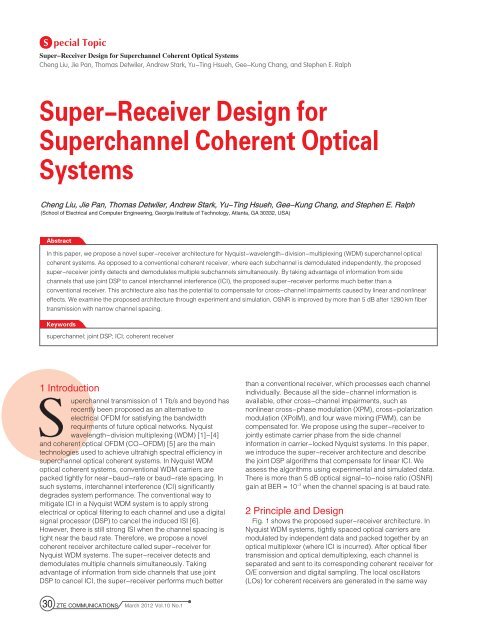ZTE Communications
ZTE Communications
ZTE Communications
You also want an ePaper? Increase the reach of your titles
YUMPU automatically turns print PDFs into web optimized ePapers that Google loves.
S pecial Topic<br />
Super-Receiver Design for Superchannel Coherent Optical Systems<br />
Cheng Liu, Jie Pan, Thomas Detwiler, Andrew Stark, Yu-Ting Hsueh, Gee-Kung Chang, and Stephen E. Ralph<br />
Super-Receiver Design for<br />
Superchannel Coherent Optical<br />
Systems<br />
Cheng Cheng Liu, Liu, Jie Jie Pan, Pan, Thomas Thomas Detwiler, Detwiler, Andrew Andrew Stark, Stark, Yu-Ting Yu-Ting Hsueh, Hsueh, Gee-Kung Gee-Kung Chang, Chang, and and Stephen Stephen E. E. Ralph Ralph<br />
(School of Electrical and Computer Engineering, Georgia Institute of Technology, Atlanta, GA 30332, USA)<br />
Abstract<br />
In this paper, we propose a novel super-receiver architecture for Nyquist-wavelength-division-multiplexing (WDM) superchannel optical<br />
coherent systems. As opposed to a conventional coherent receiver, where each subchannel is demodulated independently, the proposed<br />
super-receiver jointly detects and demodulates multiple subchannels simultaneously. By taking advantage of information from side<br />
channels that use joint DSP to cancel interchannel interference (ICI), the proposed super-receiver performs much better than a<br />
conventional receiver. This architecture also has the potential to compensate for cross-channel impairments caused by linear and nonlinear<br />
effects. We examine the proposed architecture through experiment and simulation. OSNR is improved by more than 5 dB after 1280 km fiber<br />
transmission with narrow channel spacing.<br />
Keywords<br />
superchannel; joint DSP; ICI; coherent receiver<br />
S1 Introduction<br />
uperchannel transmission of 1 Tb/s and beyond has<br />
recently been proposed as an alternative to<br />
electrical OFDM for satisfying the bandwidth<br />
requirments of future optical networks. Nyquist<br />
wavelength-division multiplexing (WDM) [1]-[4]<br />
and coherent optical OFDM (CO-OFDM) [5] are the main<br />
technologies used to achieve ultrahigh spectral efficiency in<br />
superchannel optical coherent systems. In Nyquist WDM<br />
optical coherent systems, conventional WDM carriers are<br />
packed tightly for near-baud-rate or baud-rate spacing. In<br />
such systems, interchannel interference (ICI) significantly<br />
degrades system performance. The conventional way to<br />
mitigate ICI in a Nyquist WDM system is to apply strong<br />
electrical or optical filtering to each channel and use a digital<br />
signal processor (DSP) to cancel the induced ISI [6].<br />
However, there is still strong ISI when the channel spacing is<br />
tight near the baud rate. Therefore, we propose a novel<br />
coherent receiver architecture called super-receiver for<br />
Nyquist WDM systems. The super-receiver detects and<br />
demodulates multiple channels simultaneously. Taking<br />
advantage of information from side channels that use joint<br />
DSP to cancel ICI, the super-receiver performs much better<br />
30<br />
<strong>ZTE</strong> COMMUNICATIONS<br />
March 2012 Vol.10 No.1<br />
than a conventional receiver, which processes each channel<br />
individually. Because all the side-channel information is<br />
available, other cross-channel impairments, such as<br />
nonlinear cross-phase modulation (XPM), cross-polarization<br />
modulation (XPolM), and four wave mixing (FWM), can be<br />
compensated for. We propose using the super-receiver to<br />
jointly estimate carrier phase from the side channel<br />
information in carrier-locked Nyquist systems. In this paper,<br />
we introduce the super-receiver architecture and describe<br />
the joint DSP algorithms that compensate for linear ICI. We<br />
assess the algorithms using experimental and simulated data.<br />
There is more than 5 dB optical signal-to-noise ratio (OSNR)<br />
gain at BER = 10 -3 when the channel spacing is at baud rate.<br />
2 Principle and Design<br />
Fig. 1 shows the proposed super-receiver architecture. In<br />
Nyquist WDM systems, tightly spaced optical carriers are<br />
modulated by independent data and packed together by an<br />
optical multiplexer (where ICI is incurred). After optical fiber<br />
transmission and optical demultiplexing, each channel is<br />
separated and sent to its corresponding coherent receiver for<br />
O/E conversion and digital sampling. The local oscillators<br />
(LOs) for coherent receivers are generated in the same way

















